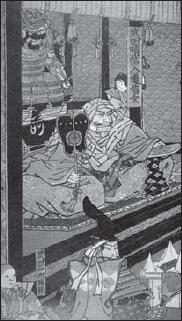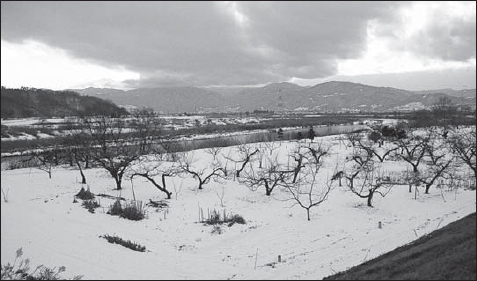
Kawanakajima is one of the most evocative of all the 16th-century Japanese battlefields. The best starting point is Nagano City. If you have arrived at Nagano from either Tokyo or Nagoya you will have already crossed the battlefield by train. Take a bus (20 minutes) for Matsushiro, and alight at Kawanakajima. The bus stop is next to Hachimanbara and its splendid statues of the single-combat beside a simple Shinto shrine among the trees. As well as the site itself there is a modern museum that has a very good audio-visual show in Japanese about the fourth battle of Kawanakajima. The grave of Morozumi Masakiyo is to the north, on the way back to Nagano.

Takeda Shingen holds court at his mansion of Tsutsugasaki. Several portraits of Shingen survive show a consistently strong image. He was a solidly built, determined-looking man, portrayed in later life with elaborate side-whiskers.
To complete the tour walk half a mile down to the Chikumagawa River and see Nobushige’s grave in the temple called the Tenkyuji, which is on the right just before the modern bridge. The main hall of the temple houses a renowned image of Emma-do, the guardian of hell. There is a very interesting little museum, which contains, among other items, one of Shingen’s helmets. Yamamoto Kansuke’s grave may be seen by crossing the bridge. Then take the bus again or walk into the pleasant town of Matsushiro and see the ruins of Kaizu Castle and a number of historic buildings associated with the Sanada family. The more energetic may then climb Saijosan for the panoramic view from Kenshin’s camp.
Northwest of Nagano lie the anonymous-looking hills on which the castles of Asahiyama and Katsurayama once stood. The Togakushi area is very interesting and has many other historical associations with the site of the cave where Amaterasu the Sun Goddess hid. This is now marked by a series of shrines, and there is a ninja museum in the vicinity. Across the Chikumagawa valley from Motodoriyama is the world-famous spa of Shiga Kogen where the wild monkeys come down to share the baths with humans!

The Chikumagawa looking towards the southwest and the site of the ford of Amenomiya, where Kenshin crossed the river on his way to and from Saijosan.

Another scene from the 2001 re-enactment of Takeda Shingen’s departure for war at Kofu. The banners display the Mon badges of various Takeda retainers.
Strange to relate, the main re-enactment events designed to celebrate the battles of Kawanakajima take place nowhere near Nagano. Instead one must journey to Yonezawa in Yamagata Prefecture, the castle town that became the Uesugi fief after the fall of Uesugi Kagekatsu, to see the ‘Uesugi Butei Shiki’ – the ceremony of Uesugi Kenshin departing for war. In recent years this has included a battle re-enactment as well. Yonezawa also has a very lively society of arquebus enthusiasts, who may be seen firing their weapons at various festivals around the country.
Not to be outdone, Kofu, Takeda Shingen’s capital, has its own spectacular Takeda departure re-enactment as part of its annual spring festival every April. At nearby Isawa, which has a convenient dried-up riverbed not unlike the Saigawa, there is a large-scale annual re-enactment of the battle of Kawanakajima with thousands of enthusiastic participants. Details of all these events may be found through the Japan Tourist Organisation, which has branches in major capital cities.